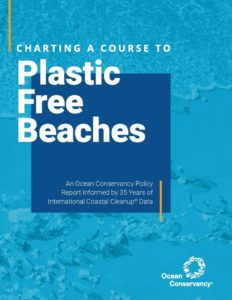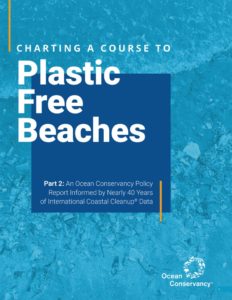Charting a Course to Plastic Free Beaches
Ocean Conservancy policy reports informed by more than 35 years of ICC data
Since 1986, Ocean Conservancy has mobilized millions of volunteers through the International Coastal Cleanup® (ICC), the world’s largest volunteer effort to rid the ocean and waterways of plastics and marine debris. As this cleanup effort has grown through the years, two things remain constant: the dedicated effort to clean up our ocean and the equally dedicated effort to collect vital data about plastic pollution to motivate big picture solutions. Since it’s inception ICC volunteers in the United States and more than 150 countries have recorded data on nearly 400 million pieces of trash fouling our shorelines.
Right now, each year, approximately 11 million metric tons of plastics flow into the ocean from land-based sources alone. That is more than a garbage truck’s worth of plastic waste each minute. Without immediate and bold action, this number could more than double by 2040, according to a 2020 study co-authored by Ocean Conservancy. To reverse the trend of more and more plastics ending up in our ocean and our communities, we need to make dramatic changes to how we produce, use and dispose of plastics. Ocean Conservancy’s reports, “Charting a Course to Plastic Free Beaches” Part 1 and Part 2, examine and recommend ways to do just that.
Guided by nearly 40 years of ICC data from around the world, these reports provide guidance on policies and strategies that reduce plastics at their source through three steps:
-
- Reducing the amount of plastics being produced, including by banning some of the most polluting items;
- Redesigning other single-use plastic items to be fully reusable, recyclable or compostable;
- Revamping our recycling system.
By homing in on the items most collected by ICC volunteers, this charter provides the tools and guidance needed to meet the goal of plastic-free beaches.
Step 1: Reduce Plastic Production
 Nearly four decade’s worth of data from Ocean Conservancy’s ICC provides a clear path to reducing the most polluting plastics. Eliminating or significantly reducing the use of just four common single-use plastic items through bans or by-request laws—straws, utensils, bags and cigarette butt filters—would cut one million metric tons of plastics from circulation each year. Banning foam foodware products, including foam cups and clamshell containers, would eliminate more than 48 billion single-use plastic items and countless microplastics annually.
Nearly four decade’s worth of data from Ocean Conservancy’s ICC provides a clear path to reducing the most polluting plastics. Eliminating or significantly reducing the use of just four common single-use plastic items through bans or by-request laws—straws, utensils, bags and cigarette butt filters—would cut one million metric tons of plastics from circulation each year. Banning foam foodware products, including foam cups and clamshell containers, would eliminate more than 48 billion single-use plastic items and countless microplastics annually.
Banning these highly polluting and easily replaceable items, along with legislation to reduce plastics across the board, would go a long way in reducing plastic production at the source.
Step 2: Redesign Plastic Products
 Some of the most common single-use plastic items found on beaches can’t be easily eliminated or banned. Ideally, items such as plastic food wrappers, bottles, bottle caps, cups and lids must be redesigned, produced and delivered to be reusable; or, when that isn’t possible these items should actually be recyclable. Rethinking and redesigning these plastic items will take a concerted effort by corporations, which will only happen if government takes action to regulate these products.
Some of the most common single-use plastic items found on beaches can’t be easily eliminated or banned. Ideally, items such as plastic food wrappers, bottles, bottle caps, cups and lids must be redesigned, produced and delivered to be reusable; or, when that isn’t possible these items should actually be recyclable. Rethinking and redesigning these plastic items will take a concerted effort by corporations, which will only happen if government takes action to regulate these products.
Step 3: Revamp Recycling
We can’t recycle our way out of this crisis. We also can’t solve this crisis without vastly improving recycling.
We need to improve our recycling systems so we can better reuse plastics that have already been produced and avoid using more fossil fuel-based virgin plastics. To do this, we must reduce the amount of plastics we use in the first place, improve the design of products so they can actually be recycled, ensure products are accurately labeled for recycling, standardize what is collected across different jurisdictions and increase collection rates.
To do all of this, we need to hold plastic producers financially accountable for their products and push them to invest in our circular economy through reuse and mechanical recycling. We can do this through extended producer responsibility policies that couple investments in our existing recycling system with requirements for better product design and labeling standards along with source reduction and reuse requirements.
Together with concerted cleanup efforts, these measures provide a path to significantly reducing plastics production and plastic pollution, and to moving toward the goal of trash free seas.